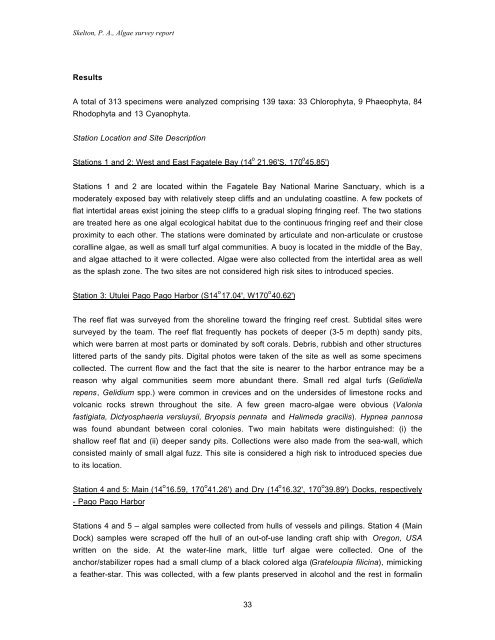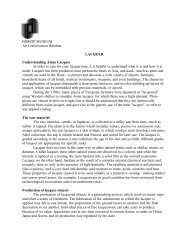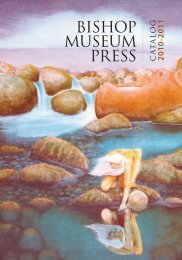INTRODUCED MARINE SPECIES IN PAGO ... - Bishop Museum
INTRODUCED MARINE SPECIES IN PAGO ... - Bishop Museum
INTRODUCED MARINE SPECIES IN PAGO ... - Bishop Museum
Create successful ePaper yourself
Turn your PDF publications into a flip-book with our unique Google optimized e-Paper software.
Skelton, P. A., Algae survey report<br />
Results<br />
A total of 313 specimens were analyzed comprising 139 taxa: 33 Chlorophyta, 9 Phaeophyta, 84<br />
Rhodophyta and 13 Cyanophyta.<br />
Station Location and Site Description<br />
Stations 1 and 2: West and East Fagatele Bay (14 o 21.96'S, 170 o 45.85')<br />
Stations 1 and 2 are located within the Fagatele Bay National Marine Sanctuary, which is a<br />
moderately exposed bay with relatively steep cliffs and an undulating coastline. A few pockets of<br />
flat intertidal areas exist joining the steep cliffs to a gradual sloping fringing reef. The two stations<br />
are treated here as one algal ecological habitat due to the continuous fringing reef and their close<br />
proximity to each other. The stations were dominated by articulate and non-articulate or crustose<br />
coralline algae, as well as small turf algal communities. A buoy is located in the middle of the Bay,<br />
and algae attached to it were collected. Algae were also collected from the intertidal area as well<br />
as the splash zone. The two sites are not considered high risk sites to introduced species.<br />
Station 3: Utulei Pago Pago Harbor (S14 o 17.04', W170 o 40.62')<br />
The reef flat was surveyed from the shoreline toward the fringing reef crest. Subtidal sites were<br />
surveyed by the team. The reef flat frequently has pockets of deeper (3-5 m depth) sandy pits,<br />
which were barren at most parts or dominated by soft corals. Debris, rubbish and other structures<br />
littered parts of the sandy pits. Digital photos were taken of the site as well as some specimens<br />
collected. The current flow and the fact that the site is nearer to the harbor entrance may be a<br />
reason why algal communities seem more abundant there. Small red algal turfs (Gelidiella<br />
repens, Gelidium spp.) were common in crevices and on the undersides of limestone rocks and<br />
volcanic rocks strewn throughout the site. A few green macro-algae were obvious (Valonia<br />
fastigiata, Dictyosphaeria versluysii, Bryopsis pennata and Halimeda gracilis). Hypnea pannosa<br />
was found abundant between coral colonies. Two main habitats were distinguished: (i) the<br />
shallow reef flat and (ii) deeper sandy pits. Collections were also made from the sea-wall, which<br />
consisted mainly of small algal fuzz. This site is considered a high risk to introduced species due<br />
to its location.<br />
Station 4 and 5: Main (14 o 16.59, 170 o 41.26') and Dry (14 o 16.32', 170 o 39.89') Docks, respectively<br />
- Pago Pago Harbor<br />
Stations 4 and 5 – algal samples were collected from hulls of vessels and pilings. Station 4 (Main<br />
Dock) samples were scraped off the hull of an out-of-use landing craft ship with Oregon, USA<br />
written on the side. At the water-line mark, little turf algae were collected. One of the<br />
anchor/stabilizer ropes had a small clump of a black colored alga (Grateloupia filicina), mimicking<br />
a feather-star. This was collected, with a few plants preserved in alcohol and the rest in formalin<br />
33






